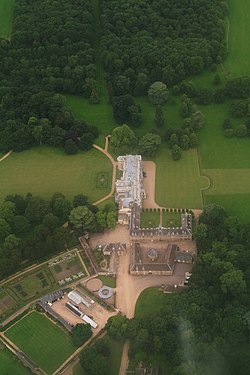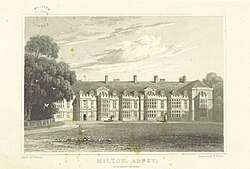Milton Hall
| Milton Hall | |
| Northamptonshire | |
|---|---|
 Milton Hall from the air | |
| Location | |
| Grid reference: | TL14499986 |
| Location: | 52°35’4"N, 0°18’42"W |
| History | |
| Built 1594 | |
| For: | William Fitzwilliam |
| Country house | |
| Information | |
Milton Hall is a grand country house in Northamptonshire, in the fen country of the Soke of Peterborough at the north-eastern extent of the county. The house is found three miles from Peterborough city centre, off the A47 trunk road, between the Peterborough suburb of Westwood and the village of Castor. The parkland, Milton Park, stretches south to the bank of the River Nene, which marks Northamptonshire's border with Huntingdonshire.
This is the largest private house in the Soke and one of the largest in the county.
The house dates from 1594. It was the historical home of the Fitzwilliam family and the Earls Fitzwilliam. The house is surrounded by an extensive park of some 35 acres spreading out to the south of the house, in which some original oak trees from an earlier Tudor deer park survive.
The house is a Grade I listed building;[1] the garden is Grade II* listed.
The house and grounds are private and not open to the public; however, Peterborough Milton Golf Club has a par 71 parkland course set in the grounds of the estate, with many of the holes being played in full view of Milton Hall.
History
The evolution of the hall
In the Middle Ages, Milton was a hamlet in the parish of Castor. The manor of Milton[2] was bought from Robert Wittlebury in 1502 by Sir William Fitzwilliam, a wealthy merchant from an old Yorkshire family. He was knighted in 1515 and died in 1534.
The oldest parts of the Hall were built in the 1590s by William's grandson, the third William Fitzwilliam and Lord Deputy of Ireland, who also began to lay out grounds. He was succeeded in 1599 by his son, the fourth William, who continued to work on the Hall and possibly developed the landscape. On his death in 1618 he was succeeded by his son, later the first Baron Fitzwilliam, whose granddaughter Jane married Sir Christopher Wren. A plan dated 1643 records the grounds at this time enclosed by a moat and containing courtyards, fishponds, orchards and gardens.
The third Baron was elevated to Viscount Milton and Earl Fitzwilliam, and it was he who added the imposing stables in about 1690, choosing William Talman and John Sturges as his architects. John Fitzwilliam, the second Earl, succeeded in 1719 and the following year completed an extension to the stable block and continued the work his father had started on enlarging the park and altering the gardens to the south of the Hall to include the walled enclosures which still survive.
John's son William, the third Earl, married Lady Anne Wentworth, daughter of the first Marquess of Rockingham. In 1750, after abortive projects commissioned by his grandfather and father from Talman, Gibbs and Brettingham for modernising the Hall, the third Earl engaged Lord Rockingham's architect Henry Flitcroft to begin the process, and a new south front was added. Following the death of the third Earl in 1756, the work on the Hall was completed by Sir William Chambers for his son William, the fourth Earl, in 1773. In 1782, however, the fourth Earl succeeded to Wentworth Woodhouse on the death of his uncle the second Lord Rockingham, and this became his principal seat, the family moving to Milton only in the winter for the hunting. To facilitate this he commissioned Humphry Repton (1752–1818) to offer advice on improvements to the park in 1791.
The fourth Earl died in 1833 at the age of 85 leaving his properties to his only son, Lord Milton. With Wentworth Woodhouse the principal seat of the family, the fifth Earl left Milton to his younger son, George Wentworth-FitzWilliam, in 1857. George is thought to have commissioned Harold Peto to produce plans for a garden within one of the 18th century walled enclosures.
Wartime and afterwards
The Hall was used by the military during both world wars.[3]
In the First World War, an auxiliary hospital was set up in the house. During this period, in 1917, Daphne du Maurier made the first of several visits to Milton at the age of ten along with her mother and two sisters.[4] It is clear from correspondence in later life between du Maurier and the 10th Earl that the happiness and freedom experienced during these childhood visits made an impact on the future writer which she never forgot. She told Lord Fitzwilliam that when she wrote Rebecca 20 years later, the interior of Manderley was based on her recollection of the rooms and 'big house feel' of Milton in the First World War,[3] and referred to Milton in a letter to the last Lord Fitzwilliam as "dear old Milton".
During the Second World War, part of the house and the stable block were occupied by the Czechoslovakian army and later Special Operations Executive who trained in the grounds and woods prior to being dropped by parachute behind enemy lines in France in the days leading up to the Normandy landings (known as 'Operation Jedburgh').
After the war, Lord and Lady Fitzwilliam returned to Milton to make it their home. On the death of the Countess Fitzwilliam in 1995, the estate passed to Sir Philip Naylor-Leyland, 4th Baronet.
During the Falklands War, on 30 April 1982, the Prime Minister Margaret Thatcher and her husband Denis stayed overnight at Milton on a visit to Sir Stephen Hastings (the local member of Parliament and the second husband of Sir Philip Naylor-Leyland's ex-wife). The following morning Mrs Thatcher took a call to tell her that an RAF Vulcan had successfully bombed the airfield at Stanley.
References
- ↑ National Heritage List 1162643: Milton Hall (Grade I listing)
- ↑ Parks and Gardens Data Services and quoted in accordance with their terms
- ↑ 3.0 3.1 "Five Villages, Their People and Places" A History of the Villages of Castor, Ailsworth, Marholm with Milton, Upton and Sutton
- ↑ Daphne du Maurier Myself When Young
- Neale, John Preston: 'Views of the Seats of Noblemen and Gentlemen in England, Wales, Scotland and Ireland', Volume 3 (1818)



